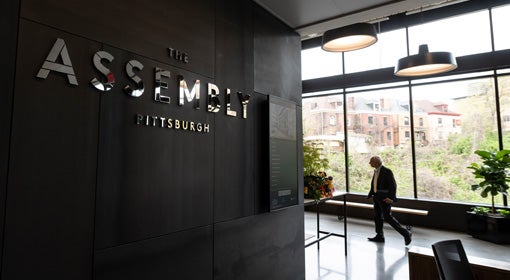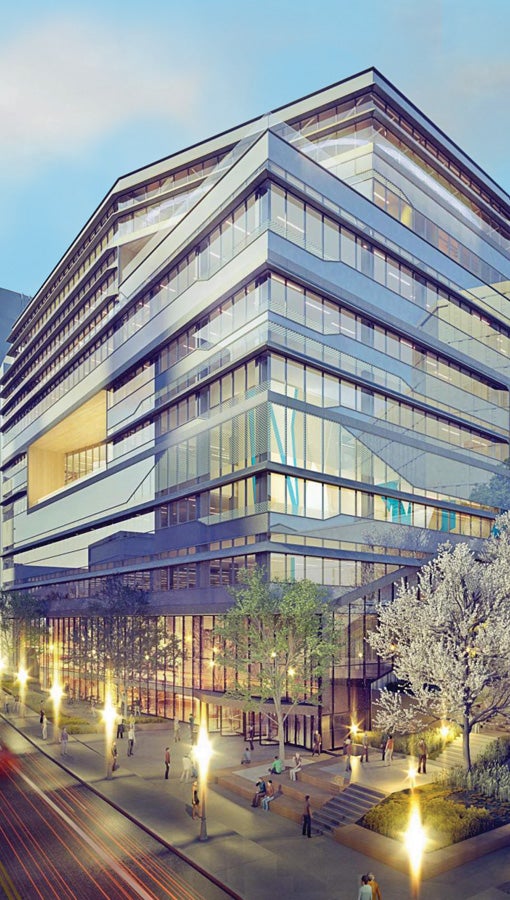
Like most great institutions, the University of Pittsburgh strives to evolve alongside the changing tides of progress. That’s especially true when it comes to envisioning and creating new facilities—and updating old ones—on and off campus. From upgrades to the beloved Hillman Library and the creation of a new student rec and wellness center to state-of-the-art research and innovation hubs fostering problem-solving collaborations, the sounds of construction at and around Pitt signify fresh opportunities to make the University, the city and the world a better place.
Chancellor Patrick Gallagher spoke with Pitt Magazine about the exciting resources and possibilities—for students, innovators and the community—emerging from some of the University’s newest building projects.
Editor-in-Chief Laura Clark Rohrer:
Last spring, Pitt and its partners opened The Assembly, a new biomedical research hub in Pittsburgh’s Shadyside neighborhood, right by the UPMC Hillman Cancer Center. What was the genesis for this project?
Chancellor Patrick Gallagher:
 Well, the name—The Assembly—hints at the history of the building. It used to be a Ford automotive plant. That part of Pittsburgh was known as Automotive Row—it’s where all the car dealerships were, and some still are. Now, it’s a research-intensive area, particularly patient-facing cancer-related research.
Well, the name—The Assembly—hints at the history of the building. It used to be a Ford automotive plant. That part of Pittsburgh was known as Automotive Row—it’s where all the car dealerships were, and some still are. Now, it’s a research-intensive area, particularly patient-facing cancer-related research.
The Assembly is all about providing more state-of-the-art space for research performed by Pitt scientists. Some of the most advanced work in cancer therapy and immunotherapy is going to happen here. Research, however, is conducted not only to advance our understanding but also because it produces useful things like new therapies, new drugs, new treatments—and many of these are commercialized. So, The Assembly was specifically designed to allow interaction with companies and startups. It has become one of our front doors to the business community and those who want to, as I always say, be one cup of coffee away from their collaborators at Pitt.
Why have an innovation hub like this off campus?
Research-related spaces are important to the University, but they’re also important to a whole variety of people and companies with whom we work closely. Location plays a big role. The magic of innovation is typically not found in any one place. It often happens at the boundaries.
That’s really what we talk about when we talk about innovation districts or innovation ecosystems. These are all analogies to imply a magic mix of ingredients that, when brought together, can make something special. That kind of work can happen near existing centers of gravity. Any great university, any great research hospital should have a lot of this activity right around its perimeter, and that’s where The Assembly fits.
There’s been a lot of focus on bringing new vibrancy to buildings on Pitt’s campuses, too. Is the new recreation and wellness center in Oakland an example of that?
Absolutely. The rec center is a need that goes way back, and it addresses the fact that we’re a residential university. Rest, relaxation, camaraderie—all these things that are essential parts of the college experience, and not all our spaces support that well. This rec center is going to be a game changer in terms of the quality of those facilities that support student well-being, like student health, yoga, meditation, fitness and nutrition. It’s expected to open in 2024 and will be a transformative space for our campus.
When alumni visit, are there other changes you think they might notice?
 Well, some of our most iconic spaces have been refreshed and changed. The Hillman Library is a great example. It was badly in need of renovation and upgrade, but we also had to acknowledge that how we use libraries has fundamentally changed from when Hillman was originally designed. We’re in the final phase of that renovation, and the floors that are already completed are spectacular.
Well, some of our most iconic spaces have been refreshed and changed. The Hillman Library is a great example. It was badly in need of renovation and upgrade, but we also had to acknowledge that how we use libraries has fundamentally changed from when Hillman was originally designed. We’re in the final phase of that renovation, and the floors that are already completed are spectacular.
Our medical and health science alumni are also going to see a major change to Scaife Hall with the new wing, which is principally dedicated to our medical education spaces. That renovation is embracing some of the latest thinking on how you teach medicine, how physicians learn best and what spaces support that.
There's just been a lot of important work to maintain and refresh the places where our community teaches, studies, and does research. But what's really exciting to me is that it's been done so thoughtfully. In many ways, it's not just a refresh, it's a transformation. It's a new way of making sure that these spaces work with us and for us.
Is the new Big Idea Center, which just opened this fall, another example of the transformation happening at Pitt?
Absolutely—and that’s a pretty cool example. The casual campus visitor strolling by the Big Idea Center on Forbes Avenue may not recognize that they are walking by the entrance to our student entrepreneurship programs. The Center sits right next to our academic campus but is also embedded directly in that vibrant commercial sector.
The students who want to start companies and become entrepreneurs—this is where they go. This is their workspace. The Big Idea Center is something we haven’t had before. It’s our personal incubation shop for student entrepreneurs. It even has a student-run coffee shop in it called Saxbys. There’s also an adjacent commercial space nearby where a successful startup can go and have shareable space to start launching and growing.
It's one of those spaces that I hope students and alumni will drop in and see when they're in Oakland because it gives you a ‘glance, a snapshot of all the incredible creativity generated by our students. They are pursuing ideas for new services, new products, and new approaches, and you can see it happening right in front of you.
This academic year will be your last as chancellor before you step down next summer. How do these new facilities and renovations fit into your vision for Pitt today and in the future?
Well, the funny part about any discussion about space is it can leave you with the impression that a university is all about its buildings. I’ve always believed that’s the wrong way to think about a university. A university is a community of people held together by a shared dedication to learning and pushing the boundaries of knowledge. But, like any activity, where you do it and how easy it is to get it done can be enhanced by the facilities and tools that we provide.
So, I view this development as a way of lifting and supporting our people. This is a remarkable community we have at Pitt, and we should have remarkable spaces so that our people can reach their full potential.
This story is from Pitt Magazine's Fall 2022 issue. It was published on October 10, 2022.
